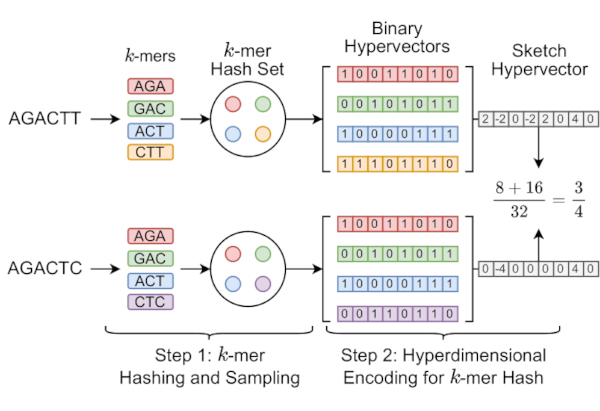1 unstable release
| 0.2.2 | Jul 28, 2024 |
|---|
#196 in Biology
115KB
2.5K
SLoC
HyperGen: Compact and Efficient Genome Sketching using Hyperdimensional Vectors
HyperGen is a Rust library used to sketch genomic files and realize fast Average Nucleotide Identity (ANI) approximation. HyperGen leverages two advanced algorithms: 1. FracMinHash and 2. hyperdimensional computing (HDC) with random indexing as shown in the following figure:

HyperGen first samples the kmer set using FracMinHash. Then the kmer hashes are encoded into hyperdimensional vectors (HVs) using HDC encoding to obtain better tradeoff of ANI estimation quality, sketch size, and computation speed. The sketch size generated by HyperGen is 1.8 to 2.7× smaller than Mash and Dashing 2. ANI estimation in HyperGen can be realized using highly vectorized vector multiplication. HyperGen's database search speed for large-scale datasets is up to 4.3x faster than Dashing 2.
Quickstart
Installation
Basic Installation
HyperGen requires Rust language and Cargo to be installed.
We recommend installing HyperGen using the following command:
git clone https://github.com/wh-xu/Hyper-Gen.git
cd Hyper-Gen
# Without GPU acceleration for sketching
cargo install --path .
Install with GPU Support
HyperGen supports GPU acceleration. Using GPU mode will require the installation of NVIDIA GPU driver. Use nvidia-smi or nvcc -V to check if the driver is installed. Then run the following command to install with GPU support:
# With GPU acceleration for sketching
cargo install --features cuda-sketch --path .
Currently only Nvidia GPUs are supported. We tested the compatibility on both desktop RTX4090 and laptop RTX4060 with CUDA Version 12.x.
Usage
Current version supports following functions:
1. Genome sketching for .fa/.fna/.fasta files
Example:
hyper-gen sketch -p ./data -o ./fna.sketch
Positional arguments:
-p, --path <PATH> Input folder path to sketch
-o, --out <OUT> Output path
-t, --thread <THREAD> Threads used for computation [default: 16]
-C, --canonical <CANONICAL> If use canonical kmer [default: true]
-k, --ksize <KSIZE> k-mer size for sketching [default: 21]
-s, --scaled <SCALED> Scaled factor for FracMinHash [default: 1500]
-d, --hv_d <HD_D> Dimension for hypervector [default: 4096]
-D, --device <DEVICE> Device to run [default: cpu] [possible values: cpu, gpu]
2. ANI estimation and database search
Example:
hyper-gen dist -r fna1.sketch -q fna2.sketch -o output.ani
Positional arguments:
-r, --path_r <PATH_R> Path to ref sketch file
-q, --path_q <PATH_Q> Path to query sketch file
-o, --out <OUT> Output path
-t, --thread <THREAD> Threads used for computation [default: 16]
-a, --ani_th <ANI_TH> ANI threshold [default: 85.0]
3. Faster sketching on GPU
HyperGen supports offloading the kmer hashing and sampling steps to GPU to speed up the sketching process. Use the following command to run on GPU device:
hyper-gen sketch -D gpu -p ./data -o ./fna.sketch
Differences between Mash and HyperGen

- (a) Mash uses MinHash to sample kmer hash set and stores discrete hash values as the genome sketch.
- (b) HyperGen uses FracMinHash to sample kmer hash set and encodes discrete hash values into continuous sketch hypervector.
Publication
- Weihong Xu, Po-kai Hsu, Niema Moshiri, Shimeng Yu, and Tajana Rosing. "HyperGen: Compact and Efficient Genome Sketching using Hyperdimensional Vectors." Bioinformatics, 2024.
Contact
For more information, post an issue or send an email to wexu@ucsd.edu.
Dependencies
~11–27MB
~451K SLoC